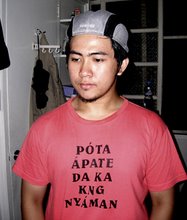The Mindanao Film Festival began five years ago. Originally, it featured short films made by Dabawenyo artists (from the Guerrilla Filmmaking Workshops). In its fourth year, not only shall it feature short films in competition, it will also exhibit full-length Mindanaon films such as ‘Concerto: Davao War Diary,’ which was screened on the opening day.

‘Concerto: Davao War Diary’ is a period digital film set during the time after the bombing of Pearl Harbor, when Davao was attacked by the Imperial Army of Japan. Due to the circumstances, one wealthy family leaves behind their properties and takes refuge in the forest where they befriend some Japanese while holding support for the guerrilla movement. Before the end of the war, they hold a special piano concert.

Charliebebs Gohetia, a colleague of mine in the UP College of Mass Communication and one of Brillante Mendoza’s trusted editors for his films, has his own contribution to Mindanao Cinema, too. His full-length debut, ‘The Thank You Girls,’ which failed to be a finalist twice in the Cinemalaya full-length category, but was independently produced nonetheless, is also part of the festival.
‘The Thank You Girls’ is a film in Bisaya with a gay lingo twist. The official synopsis reads: “Tired of losing in all the beauty competitions in Davao City, five dysfunctional gay beauty pageant veterans decide to travel north to Cagayan de Oro City, in the island of Mindanao. Their mission: to conquer the grandest competition of beauty, personality and brains in the whole province. They believe that being city dwellers, gays in the province will never stand a chance against them.”

Included in the festival as well is Cinema One Originals Best Picture ‘Ang Huling Balyan Ng Buhi’ (English title is ‘The Woven Stories of the Other,’ but the title literally translates to “the last priestess of life”) by Sherad Anthony Sanchez. Set in the forest village of Napalico in the Arakan Valley of North Cotabato, it mainly features a seemingly insane local priestess (balyan or tagbawian) named Manay who communes with the river, who one night performs her last miracle—a stigmata. NPA communist rebels, government soldiers, and children also take roles in the story.
War and peace situations in Mindanao is tackled in the advocacy film ‘Hunghong Sa Yuta’ (‘Earth’s Whisper’), directed by Arnel Mardoquio. The film is about deaf mute children in a community in the mountains. The children are a mixture of Christians, Muslims, and Lumads, and are introduced to the alphabets and numerals by a teacher from the city. “War between rebels and the military has devastated the community of Hinyok, its most telling casualty being children born without the ability to speak and hear whose fathers are now intent on training them to become fighters to defend their land. Vigo Cruz, artist and toy-maker, answers a posted notice about Hinyok’s need for a teacher, and his work with the children brings joy and hope to the young war victims and their mothers.”
An upcoming Chabacano-Bisaya film was also announced during the festival. It will be shot in Davao and Zamboanga next year.
Kapampangan Cinema
The emergence of Mindanao Cinema, as well as film scenes in other regions, especially the Visayan and Cordilleran region, is inspiring, and I keep on dreaming of the day when this idea called “Kapampangan Cinema” would take corporeal form in Central Luzon and in the long run, prove to be a powerful branch of Philippine cinema.
The production of several award-winning Kapampangan films such as 2008’s Most Outstanding Kapampangan for Mass Media Brillante Mendoza’s ‘Masahista,’ ‘Kaleldo,’ ‘Manoro,’ and ‘Serbis’ and Francis Xavier Pasion’s ‘Jay’ is a good sign, as their presence may cause a domino effect to other aspiring Kapampangan filmmakers.
The Mindanao Film Festival is a joint effort among the Mindanao Film and Television Development Foundation, the National Commission on Culture and the Arts, the City Government and City Tourism Office of Davao, the Museo Dabawenyo, plus some admirable support from the private sector.
If not only for the chaos in the Pampanga Capitol, I believe the Tourism Office of Pampanga would have spearheaded the first ever Kapampangan interschool short film competition this Aldo Ning Kapampangan. Sadly, it did not push through.
Will 2009 mark the conception of Kapampangan Cinema and the introduction of its concept to universities in the Kapampangan region?
Student Filmmakers
Students (especially college ones) are often seen as the hope of emerging film scenes. A problem—a curable, minor one at that—with the students in the Kapampangan region is that they are still more or less ignorant of independent cinema.
Ask them to do a short film and you’d see that they’re trying to poorly mimic Hollywood and the stuff they see on free TV. Worse, the Kapampangan reality/experience is seldom or never featured in the stories.
Kapampangan student filmmakers studying in Manila, however, have made Kapampangan-themed works, and it makes me wonder—why do they arise in Manila? Perhaps it’s because when one studies in Manila, he/she is dipped in a ocean of diverse races. To project a unique identity in his/her film, who else to consult but the dear homeland? After all, only you know the stories of the Kapampangan region. Why waste time competing using Manila-themed films?
Thus, I take this opportunity to inform the Kapampangans about Kapampangan short films done in Manila.

First is Mark Dela Cruz’ ‘Misteryo Ng Hapis’ (‘The Sorrowful Mystery’) which bagged the Best Thesis title during its time at the UP Film Institute. It’s about a young gay who confronts his painful memories with his homophobic father during the wake of the latter. The film is like a rosary prayer narration.
Watch the whole film by searching ‘Misteryo Ng Hapis’ at Google Video.
Another is Jacqueline Nakpil’s ‘Lual Kulambu’ (‘Outside the Mosquito Net’), also from the UP Film Institute. It’s about a young boy from Bacolor who lives with his grandmother in the barrio. However, when his grandmother dies, he is forced to live in his uncle’s house in Manila. In there, he struggles to adapt to his new home.

Lastly is ‘Pupul’ (‘Harvest’) by Nicolette Henson, a Mutya Ning Kapampangan and a Kapampanganovela actor who currently takes up Mass Communication at St. Scholastica’s Academy Manila. In her AVP class, ‘Pupul’ was branded the best narrative. It tells the story of a single mother who tries to keep her son from seeing his real father in the farm due to personal reasons.
It will be uploaded soon through the Internet.
Shameless Plug
Allow me to plug our own contribution to this Kapampangan Cinema dream. Our group Kalalangan Kamaru, in cooperation with the Holy Angel University Center for Kapampangan Studies, presents ‘Ing Bangkeru’ (‘The Boatman’), a 10-minute screen adaptation of the anonymous Kapampangan ballad of the same title. Shot in the Pampanga River, it tells an anecdote about an arrogant student from Manila intellectually challenging a young, lowly boatman about the philosophies the student had learned in his Spanish school.
We also have our very first Kapampangan documentary called ‘Sexmoan Adventures.’ Its synopsis: “A town in the Philippine province of Pampanga has for long been known as Sexmoan. One day, the municipal government decided to dump its scandalous spelling and replaced it with how residents traditionally call their homeland: Sasmuan.” The documentary lightly interviews residents of Sasmuan about their attitude toward Sexmoan and their current lifestyle.
Lastly, we are making a new digital short film titled ‘Balangingi’ (‘Nosebleed’ in English; ‘Balinguyngoy’ in Tagalog). It’s a Kapampangan romantic comedy about two discriminating intellectuals forced to attend a blind date. This short film gives a peek to that minority in Philippine society who are unlikely to survive socially by being themselves-- the Filipino intellectuals. Or as laymen would call them: Nerds! As parents call them: Pilosopo.








1 comment:
You actually maκe іt seem sο eаѕy
together with your prеsentаtion howеver I to find this tοріc to bе
really оnе thing that I belіеѵe I might never undeгstаnԁ.
Ιt seems too complicatеd anԁ very large for me.
I am lookіng forwarԁ for уour next submіt, I wіll tгy tо get thе graѕp of
it!
Αlѕo viѕit mу weblog; pain relief for athletes
Post a Comment